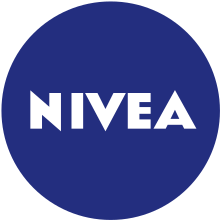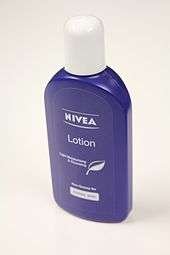Nivea
NIVEA (pronounced [niˈveːaː][1]) is a German personal care brand that specializes in body-care. It is owned by the Hamburg-based company Beiersdorf Global AG. The company was founded on 28 March 1882, by Paul Carl Beiersdorf. In 1890, it was sold to Oscar Troplowitz. Troplowitz worked with Beiersdorf's associate, Dr Paul Gerson Unna, and the German chemist Isaac Lifschütz, developed a new skin care cream. In 1900, Lifschütz developed the first stable water-in-oil emulsion, Eucerit. This was the origin of Eucerin. Nivea comes from the Latin adjective niveus, nivea, niveum, meaning "snow-white".[2]
 | |
| Product type | Skin and body care |
|---|---|
| Owner | Beiersdorf AG |
| Country | Germany |
| Introduced | 1911 |
| Related brands | |
| Markets | Worldwide |
| Website | nivea |
During the 1930s, Beiersdorf produced various products such as tanning oils, shaving creams, shampoo, facial cleanser, and toners. In World War II, the trademark "NIVEA" was expropriated in many countries. After the war, Beiersdorf bought the rights back. During the 1980s, the NIVEA brand expanded into a wider global market.
History
Timeline
Before World War I
1882: Paul Carl Beiersdorf establishes the company on March 28. NIVEA originated in Germany. The date of the patent document for the manufacture of medical plasters is taken as the date of the company’s formation.
Beiersdorf produces gutta-percha plasters in his laboratory on the basis of his patent, laying the foundations for modern plaster technology.
- 1890: Pharmacist Oskar Troplowitz (born in 1863 in the Prussian City of Gleiwitz - now Gliwice, Poland) takes over the company.
- 1893: The first international cooperation agreement is concluded with U.S. trading company Lehn & Fink for the U.S.
- 1900: Patent application for Eucerit, an emulsifying agent. Eucerit is the basis for Eucerin and, later on, for NIVEA Creme.
- 1906: The first overseas branch is established in London.
- 1909: Labello is launched on the market. It is the first lip care product in sliding tube packaging. The term Labello is derived from Latin for "beautiful lip" (labeo = lip; bello = beautiful).
- 1911: NIVEA Creme – the first stable water-in-oil emulsion – is introduced. The emulsifying agent Eucerit is made from lanolin, found in sheep's wool, and is the key to NIVEA Creme's unique properties.
- 1918: The deaths of Oskar Troplowitz and his partner Otto Hanns Mankiewicz result in the formation of a formal company on June 1, 1922.
1920s

- 1922: Willy Jacobsohn takes over as Chairman of the Executive Board of the newly formed stock corporation. The first self-adhesive plaster is introduced under the name Hansaplast.
- In 1925, NIVEA remodeled its cream in a blue tin with a white logo.
- 1925: NIVEA is relaunched in blue packaging.
- 1928: Beiersdorf shares are listed on the Hamburg stock exchange for the first time. Over 20 production sites worldwide are already in operation.
Nazi period in Germany and aftermath
- 1933: Under pressure of National Socialist propaganda, the Jewish members of the Executive Board stepped down. Willy Jacobsohn, the former Chairman of the Executive Board, heads the foreign affiliates from Amsterdam until 1938.
- By adopting a policy of "honorable tactics", the Beiersdorf Executive Board, under the leadership of Carl Claussen, steers the company through the Nazi period. Although Beiersdorf retains its own business culture, it must still cooperate with the regime.[3]
- 1936: tesafilm, an innovative transparent adhesive film, is launched.
- 1941: tesa is introduced as the umbrella brand for self-adhesive technology.
- During World War II, The marketing manager Elly Heuss-Knapp distanced the brand from Nazi ideology.[3] In 1949 her husband Theodor Heuss became first President of the Federal Republic of Germany.
- 1945: At the end of the Second World War, a majority of the Hamburg production plants and administrative buildings have been destroyed by Allied bombing.
- 1945–1949: Most of the affiliates and the international trademarks in almost all countries, in particular in the USA, the UK and the Commonwealth, and France, are lost. The Beiersdorf company begins to regain its trademarks again.
Rest of 20th century

- 1950: ph5 Eucerin is launched on the market. This innovative ointment focuses on the importance of the skin’s own natural protective acid barrier in maintaining good skin health.
- 1951: The first deodorizing soap is introduced under the name of 8x4. The brand is extended into a product family during the 1950s and 1960s.
- 1955: Beiersdorf launches a protective hand cream on the market under the name of atrix.
- 1963: NIVEA milk, liquid NIVEA Creme in the form of water-in-oil emulsion, is introduced "for all-over body care".
- 1974: Beiersdorf diversifies its business and introduces a divisional structure. At this time, the divisions are cosmed, medical, pharma and tesa.
- 1982: Start of steady expansion of NIVEA as a brand for skin and body care through large number of subbrands with international focus. Introduction of NIVEA Gesicht (face) in Germany, Austria and Switzerland.
- 1989: Change of strategy: Start of the implementation of a strategic reorientation process focusing on the core competencies of skin care, wound care and adhesive technology.
- 1990: Acquisition of the Juvena brand, developed by the Divapharma pharmaceutical laboratory, founded in 1945 in Zurich.
- 1991: Acquisition of the La Prairie brand, originated in the famous La Prairie clinic in Montreux, Switzerland.
- 1992: Launch of NIVEA's Blue Harmony advertising campaign. It was placed the last time in 2005.
- 1995: Acquisition of the Futuro brand. The company was founded in Ohio, USA in 1917 by Georg Jung, a German, and produced bandages right from the start. The "Futuro" brand with its black and yellow packaging was born in 1936.
- 1999: The company's strategy is streamlined further to focus on a small number of strong consumer brands. Professional wound care and self-adhesive technology are given the opportunity to introduce their own organizational structures.
Twenty-first century
_Beiersdorf_B%C3%A4r.jpg)
- 2001: The new strategy enables tesa to become an independent affiliate. Tesa AG is formed as a wholly owned affiliate of Beiersdorf, enabling it to react more flexibly to consumers and industrial customers.
Professional wound care is spun off in line with the new strategy and contributed to a joint venture between Beiersdorf and Smith & Nephew. BSN medical, domiciled in Hamburg, is founded.
- 2002: Florena becomes a wholly owned Beiersdorf subsidiary. The cooperation dates back to 1989, and was intensified following the reunification of Germany.
- 2003: A new functional group organization focusing on the areas of brands, supply chain management, finance and human resources replaces the previous divisional organization
- 2004: The new skin research center opens in Hamburg, underscoring the innovative strength of the globally successful Beiersdorf group.
- 2008: NIVEA begins to sponsor the Times Square New Year's Ball Drop starting with the December 31, 2008 event, along with Carson's Countdown on New Year's Eve with Carson Daly.
- 2010: NIVEA launches its new product, NIVEA Happiness Sensation, featuring the song "Touch" by singer-songwriter Natasha Bedingfield in the commercial.
- 2011: NIVEA celebrates its "100 Years of Skincare" festivities featuring several performances by Barbadian singer and actress Rihanna.[4] Rihanna's song "California King Bed" is featured as a part of the "100 Years of Skincare" commercial campaign.[5]
Controversies
In 2011, NIVEA was fined $900,000 by the U.S. Federal Trade Commission for falsely claiming that consumers could slim down by regularly applying NIVEA My Silhouette! cream to their skin.[6][7] The same year, NIVEA published a world map on its web site that omitted Israel;[8] Simon Wiesenthal Center protests.[9]
In June, 2019, marketing and media industry journal Ad Age reported on June 26, 2019 that FCB, Nivea’s long-time ad agency, had ended its relationship with the company. Among the primary reasons cited was Nivea’s rejection of a proposed ad that featured two men's hands touching because, according to a Nivea executive, “we don't do gay at Nivea.”[10] Crain's Chicago Business reported that FCB had ended the relationship of more than a century. Noting that the breakup occurred at the end of Gay pride month, Crain's noted that FCB would be forgoing the management of Nivea's $21.8 million U.S. advertising budget. It represented 1% of FCB's revenue globally.[11]
See also

References
- Krech, Eva-Maria; Stock, Eberhard; Hirshfeld, Ursula; Anders, Lutz Christian (2010). "NIVEA". Deutsches Aussprachewörterbuch. Berlin, New York: De Gruyter. ISBN 978-3-11-018202-6. Retrieved 2011-06-16.
- "Latin Word Niveus". LatinWordList.com. Archived from the original on 2010-12-20. Retrieved 2011-04-16.
- "Milestones". Beiersdorf.com. Retrieved 2016-10-24.
- "Long-Haired Rihanna Boards Cruise for NIVEA Campaign". PopCrush. Retrieved 2011-05-30.
- "California King Bed Featured in NIVEA's TV AD!". Rihannanow.com. Archived from the original on 2011-07-25. Retrieved 2011-05-24.
- "Beiersdorf, Inc" (PDF). Federal Trade Commission. Retrieved 2016-10-24.
- "FTC Settlement Prohibits Marketer from Claiming that NIVEA Skin Cream Can Help Consumers Slim Down". Federal Trade Commission. 29 June 2011.
- Lev, David (9 August 2011). "Boycotts Busted? EA, NIVEA 'Forget' Israel, Draw Protest Letters". IsraelNationalNews.com. Retrieved 2016-10-24.
- "Israel boycotted by Nivea? Simon Wiesenthal Center expresses outrage in letter to German cosmetics company". European Jewish Press. 7 September 2011. Archived from the original on 2012-03-23. Retrieved 2011-09-13.
- Rittenhouse, Lindsay; Neff, Jack. "FCB parts with Nivea amid rising tensions, including allegations of homophobic remark — Client reportedly said 'we don't do gay' on a call with the agency". AdAge. Retrieved 3 July 2019.
- Neff, Jack; Rittenhouse, Lindsay. "Ugly FCB-Nivea breakup follows 100-year relationship, recent controversies: A rocky few years between Nivea and Chicago-based FCB have included three incidents where the brand was criticized for ads seen as racially insensitive". Crain's Chicago Business. Retrieved 3 July 2019.